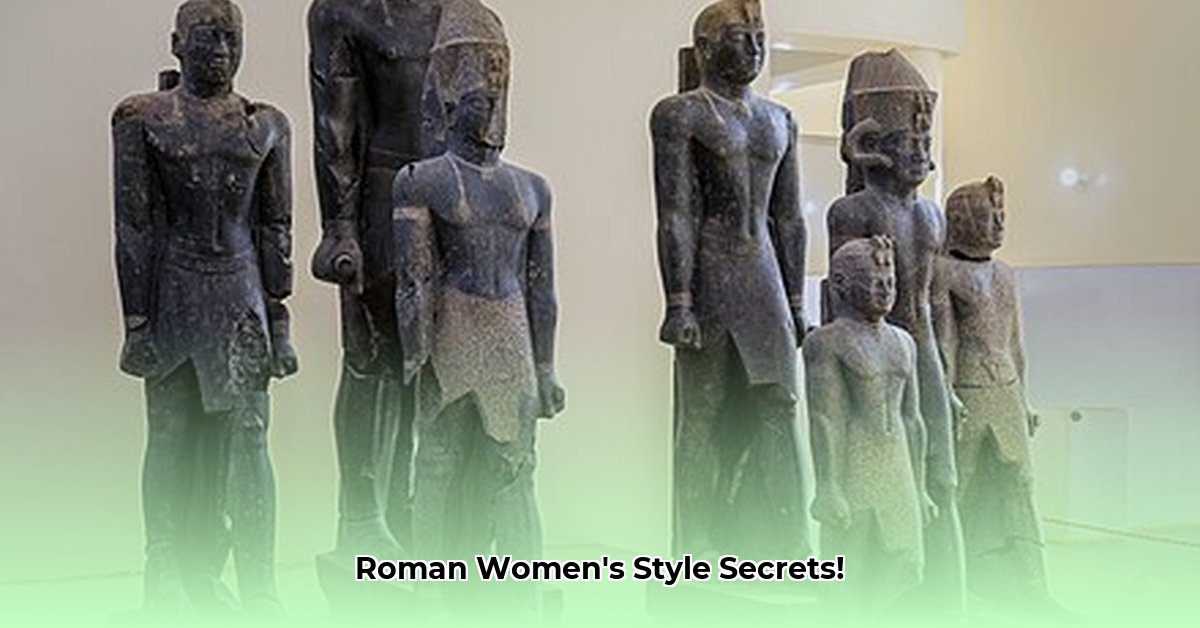Ever wondered if clothing in ancient Rome was merely about practicality? For Roman women, every garment, from the simplest tunic to an elaborate silk mantle, was a silent declaration of her identity, marital status, and social standing. Far from being a static expression, their attire reflected a dynamic interplay of tradition, wealth, and evolving societal norms within the vast Roman Empire.
For more insight, learn about Roman women’s fashion. This deep dive into ancient Roman women’s fashion will reveal the intricate language woven into their daily wear and formal ensembles. We’ll explore the foundational garments, the luxurious textiles and vibrant dyes that became powerful status symbols, the surprising methods of garment care that kept Romans looking respectable, and how even the military’s vast demand for fabric subtly influenced the hands of Roman women at their looms. Get ready to decode the fascinating secrets behind the sartorial choices that shaped the lives of women in ancient Rome.
Decoding the Roman Woman’s Wardrobe: Threads of Identity
For women in ancient Rome, clothing was a profound statement, instantly communicating their gender, social class, and personal standing. Let’s explore the key pieces that formed the foundation of their attire, each imbued with specific meaning.
The Ubiquitous Tunica: Foundation of Comfort and Class
The tunica (tunic) was the most fundamental garment for all Romans, regardless of gender or social standing. For women, this versatile, simple garment served as an underlayer, worn close to the body, much like a modern dress or slip. It typically consisted of two rectangular pieces of fabric sewn together, with openings for the head and arms.
The tunica’s appearance subtly hinted at a woman’s place in the intricate Roman social hierarchy. Tunics made from coarse, undyed wool were common among the lower classes and enslaved women, prioritizing durability and basic coverage. In contrast, elite women wore tunics crafted from finer materials like soft linen, or even luxurious imported silk, which draped elegantly and spoke volumes of their wealth. The length also varied; working women might wear knee-length tunics for practicality, while wealthier matrons favored ankle-length or foot-length garments, sometimes with longer sleeves, belting them at the waist or under the breasts to create different silhouettes.
The Stola: A Mark of Respectable Matronhood
Perhaps the most iconic garment for free, married Roman women was the stola. Worn over the tunica, the stola was a long, often voluminous dress that typically reached the ankles or feet, symbolizing the wearer’s modesty and dignity. It was commonly suspended from the shoulders by straps and often held in place with clasps or decorative brooches (fibulae) at the shoulders, allowing the fabric to fall in graceful, concealing folds.
The stola was more than just a dress; it was a badge of respectability and marital status, instantly distinguishing a free Roman matron from unmarried women, freedwomen, or women of questionable repute. While the stola was initially reserved for patrician women, its right was later extended to plebeian matrons, signifying its importance as a universal symbol of female virtue within Roman society. Any embellishments, such as a contrasting limbus (colored strip or edging) along the hem or neckline, could further indicate the wearer’s high status, adding another layer to its symbolism.
The Palla: The Versatile Outer Drape
The palla was an essential outer garment, akin to a large rectangular cloak or shawl, typically worn over the tunica and stola. Measuring up to 11 feet long and 5 feet wide for some, its versatility allowed for various elegant drapes: it could be worn as a simple coat, wrapped around the body, or stylishly draped over one shoulder and under the opposite arm. Outdoors, a chaste matron could even pull a fold of her palla over her head as a modest veil, concealing her face from the public gaze—a clear sign of her virtue and marital fidelity.
As with other garments, the material and color of a palla indicated wealth. Wealthy women might possess pallae in vivid, costly hues like saffron yellow or deep Tyrian purple, dyed with rare and expensive pigments. Poorer women, on the other hand, wore pallae made of coarser wool or linen in more muted, natural tones, prioritizing warmth and practicality over ostentatious display. The palla’s adaptability made it a functional yet stylish component, reflecting the evolving tastes of Roman women throughout the empire’s history.
Undergarments and Adornments: The Hidden World of Roman Appeal
Beneath their flowing main garments, Roman women wore essential undergarments for comfort and support. A subligaculum (loincloth or brief) was worn, similar to men’s, while a strophium or fascia pectoralis (breast-wrap or bandeau) provided basic chest support, akin to a modern bra. Archaeological finds, such as the famous “bikini girls” mosaic from Sicily, demonstrate that women also wore more tailored underwear for athletic activities.
Beyond the fundamental layers, accessories were crucial to a Roman woman’s overall appearance, adding layers of meaning and personal expression:
- Hairstyles: Roman hairstyles, particularly for elite women, evolved rapidly and were often elaborate, serving as a key indicator for dating Roman art. From intricate braids (chignons) and tightly coiled styles supported by wire frameworks to voluminous arrangements with added hairpieces made from the hair of enslaved individuals, these complex creations required the skilled hands of a specialist female slave, an ornatrix. Hairstyling shops (tonstrinae) also served both men and women. Plain woollen bands (fillets or vitae) were traditionally used to bind a chaste matron’s hair in a high-piled style known as the tutulus, especially when appearing in public.
- Jewelry: Roman women adorned themselves with a wide array of jewelry, including necklaces, bracelets, earrings, and rings, crafted from gold, silver, bronze, and glass. The Etruscans profoundly influenced early Roman jewelry, with sophisticated techniques like granulation and filigree. As the Empire expanded, access to precious stones like amethysts, emeralds, and sapphires became more widespread, leading to intricate designs featuring carved gemstones (cameos and intaglios). Hairnets woven from gold wire, diadems (tiaras), and elaborately designed hairpins were also popular, providing further opportunities for personal embellishment and a display of wealth.
- Footwear: Roman women’s footwear combined practicality with elegance. The common one-piece shoe (carbatina) and thin-soled sandals (soleae) were everyday choices. More robust, hobnailed walking shoes (calcei) or soft, laced half-shoes (socci) were also worn. For the wealthy, shoemakers created intricate designs with delicate strapwork, colorful dyes, and even gold leaf. Brides on their wedding day traditionally wore distinctive orange-colored slippers (lutei socci). While most shoes were flat-soled, the material and embellishments clearly distinguished status, with poorer women opting for durable, simple designs and the elite showcasing luxurious, fine leather or felt slippers indoors.
- Cosmetics and Perfume: Roman women (and some men) frequently used cosmetics. Lead white served as face powder, red ochre and madder for blush, and kohl for darkening eyelashes and eyebrows. Perfumes, made from natural oils and aromatic plants, were also widely used. The possession and use of these items, often stored in ornate caskets, were further indicators of a woman’s wealth and attention to personal adornment.
Dyes and Textiles: A Spectrum of Roman Craftsmanship
The materials and colors used in ancient Roman women’s clothing were a direct reflection of both local production and extensive trade networks. Understanding these elements illuminates the economic prowess and social distinctions of the era.
The Fabric Palette: From Humble Wool to Exotic Silk
- Wool: As the most commonly used fiber, wool was fundamental to Roman clothing. Italian sheep, particularly those from Tarentum, were renowned for their high-quality wool, though imports from regions like Miletus and Gallia Belgica also provided exceptional qualities, including heavy, rough wool suitable for colder climates. Most garments favored white wool, which could be bleached or dyed, but naturally dark wool was used for practical work clothes and mourning attire like the toga pulla. Spinning and weaving wool were considered virtuous occupations for Roman women of all classes, with wealthy matrons like Augustus’s wife, Livia, famously demonstrating their traditional values by producing homespun clothing.
- Linen: Produced from flax and hemp, linen provided a lighter, cooler alternative to wool, particularly favored in warmer months. While natural linen faded to an off-white, it was often bleached as it did not readily absorb dyes. The finest linen, known for its whiteness, was imported from Spanish Saetabis, while the strongest came from Retovium, highlighting the regional specializations in textile production.
- Silk: Imported from China as early as the 3rd century BCE, silk was the ultimate luxury fabric. Raw silk was bought by Roman traders in Phoenician ports like Tyre and Berytus, then woven and dyed in the Eastern Roman provinces. As Roman weaving techniques advanced, silk was fashioned into exquisite damasks, tabbies, and tapestries, some with incredibly fine thread counts. Its immense cost and association with extravagance led to various sumptuary laws attempting to limit its use. Seneca the Elder famously criticized silk garments for their immodesty, suggesting they revealed more than they concealed, particularly for women.
- Cotton: Imported from India, cotton was prized for its softness and lightweight quality, making it ideal for summer wear. Unlike linen, cotton readily absorbed dyes, allowing for vivid colors. It was sometimes interwoven with linen to create durable, brightly colored fabrics.
- Other Fibers: Less common but equally luxurious fibers included wild silk (from cocoons collected after the insect had emerged), sea silk (a shimmering golden fiber from a large Mediterranean clam), and strong, fine fabrics woven from nettle stems or poppy-stem fiber interwoven with flax for a glossy finish.
The Art of Dyeing: Color as a Status Symbol
Roman dyers had access to a vast palette of colors derived from plants, insects, and minerals.
* Tyrian Purple: The most prestigious and expensive dye, extracted from murex snails, produced hues ranging from “dried-blood” red to deep violet. Its long-standing association with royalty and the divine made it the ultimate status symbol, largely reserved for the Emperor and high-ranking officials. Despite sumptuary laws, wealthy women and even some men found ways to flaunt this coveted color.
* Saffron Yellow: Admired for its deep, fiery orange-yellow hue, saffron was costly and associated with purity and constancy. It was notably used for the flammeum, the distinctive flame-colored veil worn by Roman brides and the Flaminica Dialis, the high priestess of Jupiter.
* Reds: Madder was one of the most accessible and cheapest sources for red dyes.
* Blues: Indian indigo brought a desirable and costly dark blue to Rome, sometimes even serving as a base for counterfeit Tyrian purple.
* Greens and Browns: Various plant-based dyes created shades of green and brown.
* Blacks: Achieved using iron salts and oak gall.
The meticulous process of dyeing, combined with the rarity and source of some pigments, meant that vibrant, pure colors were exclusive to the elite, turning clothing into an immediate visual indicator of immense wealth and influence.
Sumptuary Laws and Social Signals: Rules of the Roman Runway
Roman society placed immense importance on social status, and clothing served as a highly visible marker. To maintain social order and, at times, to curb perceived moral decay from excessive luxury, the Roman elite frequently enacted sumptuary laws. These regulations attempted to dictate who could wear certain fabrics, colors, or decorations, typically reserving them for specific social classes or occasions.
For instance, the use of Tyrian purple was often restricted, making it illegal for anyone but the Emperor or designated officials to wear solid purple garments. Similarly, laws were passed to forbid men from wearing silk, viewing it as effeminate. While these laws often proved difficult to enforce and were frequently flouted by the wealthy elite eager to display their status, they highlight the Roman concern for maintaining distinct social boundaries.
Despite legal prohibitions, wealthy, upwardly mobile freedmen sometimes dared to wear forbidden colors or even togas, showcasing their ambition, only to face public mockery or eviction from high-status seats at public games. Conversely, high-caste women convicted of adultery were forbidden the respectable stola and might instead be compelled to wear a toga muliebris (a “woman’s toga”), a mark of infamy. These regulations underscore how deeply clothing was intertwined with a person’s moral standing and public reputation in Roman society.
Garment Care: The Ingenuity of Fullonicae
In a world without modern conveniences, maintaining clean and bright clothing was a significant challenge, yet crucial for upholding one’s social standing. Roman laundry practices were surprisingly sophisticated, centered around specialized establishments known as fullonicae (ancient laundries). These businesses were vital for both public hygiene and the meticulous care of garments, especially the expensive, snow-white togas prized by the senatorial class.
The Surprising Laundry Solution: Urine!
One of the most remarkable and, to modern sensibilities, surprising primary cleaning agents used by fullers (fullones) was aged urine. The ammonia in urine acted as a potent natural detergent, effectively breaking down dirt, grime, and grease. Public urinals were often strategically placed to facilitate the collection of this essential cleaning liquid.
The Meticulous Cleaning Process
The process of washing and finishing clothes in a fullonica was labor-intensive and involved several distinct steps:
- Soaking and Stomping: Garments were first submerged in large vats containing a mixture of water, alkaline substances (like fuller’s earth or soda), and aged urine. Then, bare-footed fullers would literally stomp on the clothes in the v vats, agitating the mixture to thoroughly clean the fabrics, much like treading grapes.
- Rinsing: After the vigorous stomping, the garments were meticulously rinsed in multiple basins of fresh, flowing water to remove all traces of the cleaning solution and dirt.
- Drying: The cleaned items were then carefully wrung out, either manually or mechanically, and spread over intricate wicker frames or hung to dry in the sun.
- Finishing and Brightening: For white garments, sulfur fumes were used for bleaching, yielding an exceptional, snowy white. Colored garments, however, required different handling; fullers were particularly










